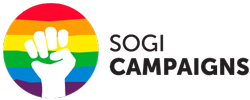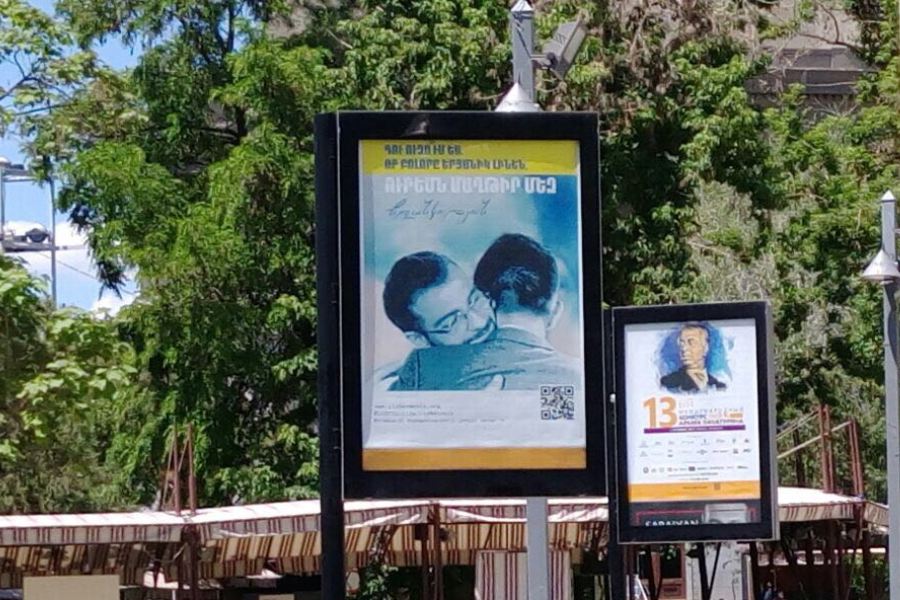Making yourself noticed
How a poster campaign went from unnoticed to banned in Armenia
Interview with Mamikon Hovsepyan
Director of Pink Armenia
A poster of two men hugging would have provoked reactions from the public in any but the most progressive cities in the world. When Pink Armenia kicked off a poster campaign in Yerevan, Armenia’s capital, in May 2017, the organisation had reason to be anxious. Yet the result could not have been more surprising: there was …. none.
Pink Armenia’s director Mamikon Hovsepyan tells us how his organisation still managed to create the much-wanted buzz.
Mamikon, how provocative was your poster campaign?
“We were anxious for the reactions of the public. Our campaign consisted of three posters that were intended to give our online video campaign more visibility. One depicts two gay men hugging, with this text on it: ‘Do you want everyone to be happy? Then wish us happiness.’
The other poster is a collage of people with different professions and states: ‘You meet them every day.’
The third poster depicts three arms and reads: ‘Trans people are part of our society.’
So, were people outraged or positive?
“This was the frustrating thing: there was no reaction. We hid at the locations were the posters were put up to observe the passers-by. We were dismayed to see that pedestrians didn’t seem to notice them.”
What did you do to save your campaign?
“Back at our offices we sent out information on our social media channels about these posters. That eventually got picked up by homophobic conservatives. Within three days, they had successfully lobbied the municipality into taking the posters down.”
On what grounds were your posters removed?
“It turned out the billboard company hadn’t bothered to ask the municipal authorities to approve the posters. Although this is formal procedure, it is hardly ever gone through. The legal restrictions on billboards are obvious and well known. There was nothing in our posters that could justify restrictions. Yet, the absence of formal authorisation gave the municipality an excuse to take the posters down.”
Wasn’t it a huge set-back that your posters got banned by the authorities?
“The positive side of the coin is that the whole ‘drama’ generated a lot of buzz. Of course, some of the buzz was negative and we got our fair share of hate mail, especially in the first two days. Still, a lot was also positive, especially when things had quietened down. The videos we had produced, and to which the posters referred to, went from 5,000 views to 50,000 views.”
What was the aim of your video campaign?
We decided to produce some videos for the International Day Against Homophobia, Transphobia and Biphobia 2017. Previously, in 2016, we had taken part with a range of organisations from our region in a collective campaign called “Demand Equality Now”
As part of this, we produced a short video “homophobia is illogical”, depicting a wounded man refusing to be treated by a gay surgeon, and collapsing as a result.
This video was well received, which inspired us to produce more.
First we drew on a committee to choose the themes we wanted to go for :
- Homo/bi/transphobic hate speech, hate crime and discrimination against LGBTI persons
- The invisibility of LGBTI persons in society
- Trans* persons’ issues
We did. We issued a call only mid-April, but still several companies responded. We decided to hire two of them to produce three videos. They got finalized in time to be released on May 17.
What angles did you eventually choose to build your communication around?
The companies came up with the initial proposals, which our team reviewed. They had set up either focus group discussions or other forms of field testing to try their ideas out and see if they worked. Some proposals were reinforcing stereotypes. In some cases, we agreed to go along with this.
For example, one video would show a wealthy male couple or urban professionals. For the agency, it was a way to show that even if it seems like you have it all, you are not complete if you can’t show your love openly. For parts of the movement, this depiction was an unwelcome reinforcement of the stereotype that all gay men are urban and wealthy. We had to navigate around these various considerations.
In another video, the company suggested to use a metaphor to talk about gender identity, as most people in Armenia don’t really understand what it means altogether. So, the company created a metaphor with apples. Apples are often used in Armenia for example in explaining mathematics to young children. Again, some members of the Trans community found that this was offensive. Of course, a metaphor is not a comparison, but that had to be explained.
We also had to come up with a solution to a specific challenge posed by the creative agency’s proposal, as it portrayed the hand representing Trans people as stereotypical MTF. So we eventually decided to have the video show several hands picking up the fruit, as a way to show the diversity of Trans people.
Did you reach out to other communities for this campaign?
Yes, we put special attention on not being discriminatory ourselves. As we always do, we consulted organisations of people with disabilities to gather their opinion. This led us to include a voice-over and subtitles on the videos, to ensure accessibility for visually and hearing-impaired people.
What learnings did you take away from this project?
First, be mindful of all possible problems. Troubleshooting and risk mitigation planning is essential. Our opponents will go out of their way to cause harm. We can’t neglect anything. For instance, we should have insisted that the billboard company go through the formal procedure to get approval for our posters. When you have lots of enemies, you must be spotless.
Second, we should realise that campaigns are not so much about what we want to say, but rather about what our target audiences can hear. It’s no use putting a message out that we like, if it won’t have an impact on our target audience.
So, target group research is essential?
Exactly. This was definitely on our mind for this campaign. But we probably should go even further and do much more research on what our target group thinks, and what messages can move them. Especially if we expect a lot of public exposure, for example if we create a TV ad. It doesn’t need to be expensive or complicated. There are easy methods to get research and testing done quickly and cheaply.
On the other hand, this could mean creating messages that could alienate parts of our movement, which we should be careful not to do. Communication and education is needed here.
Third, we need to be better prepared to talk to the media. After the poster ‘drama’ started, we got invited to several media events. But as much as we had prepared a general overarching media plan for the IDAHOT events, we hadn’t developed a specific media strategy for the videos and posters, though they were bound to attract more attention. Again, a good mitigation plan is key.



